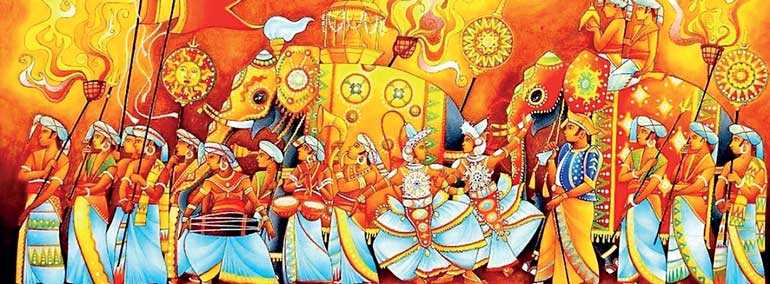Tuesday Apr 22, 2025
Tuesday Apr 22, 2025
Tuesday, 6 August 2019 01:38 - - {{hitsCtrl.values.hits}}

Grand Randoli Procession (Maha Randoli Perahara) is the last of many processions that take place. During reigns of different kings, usually the tradition was that whoever was in possession of the Sacred Tooth Relic held the divine power to rule
Grand Randoli Procession or ‘Maha Randoli Perahera’ 2019 recently commenced with grand performance of whip crackers, rhythmic drum beaters, torch bearers, Kandyan dancers and a variety of other performers that symbolise religious and cultural identities. Nevertheless, indisputably the greatest attraction among all would be for tuskers that tread majestically with the performers.
Grand Randoli Procession (Maha Randoli Perahara) is the last of many processions that take place. During reigns of different kings, usually the tradition was that whoever was in possession of the Sacred Tooth Relic held the divine power to rule. Today, Diyawadana Nilame, who is the chief lay custodian, is the curator and guardian of the Sacred Tooth Relic, who chief lay custodian (Diyawadana Nilame) is followed by the subordinate lay custodians such as ‘Basnayaka Nilames’; the incumbents of the four ‘devalas’ or temple shrines that form the latter part of the procession. 
Those who are in charge of ‘perahera’ customs include the chief lay custodian (Diyawadana Nilame) the subordinate chief of the lay custodians (Basnayaka Nilames) and the chief of laymen. The Chief Incumbents of the ‘Malwatte’ Chapter and ‘Asgiriya’ Chapters – Buddhist leaders – perform the rituals on the Tooth Relic. While it is one of Diyawadana Nilame’s main duties to organise the perahera, he also delegates a large number of officials of the Temple of the Tooth various ceremonial duties directly and indirectly related to Perahera. Every year, the magnificent Grand Randoli Procession (Maha Randoli Perahera) leaves the chief lay custodian (Diyawadana Nilame) a grand and sacred role of leadership.
In these contexts, what is inevitable in our minds are the leadership attributes, that we need an insight on, which are linked with ‘NILAME’, the lay custodian.
N – Noble
I – Inspire
L – Lead by example
A – Appreciate
M – Meaningful and challenging work
E – Empathy
Noble
A leader’s personal qualities need him necessarily to be noble. A leader’s concern should be nurturing virtues within him/her, which, researchers such as Peterson and Seligman in 2004, Opatha and Teong in 2014 identify to be honesty, gratitude, respect, benevolence and patience as the virtues. Being virtuous and at the same time noble builds trust in the followers, subordinates, and they tend to understand how important cultivating virtues within their lives is.
Inspire
A leader demonstrating an interest in career aspirations of his/her subordinates is an essential component in inspiring the subordinates. With an established inspiration, they look forward to future to create learning culture within the organisation while providing training and development opportunities for them. Identifying the varying motivational factors of different employees is crucial; some employees’ motivation can be financial gains such as salary increments, while another might find non-financial rewards, such as learning opportunities in foreign countries, etc., motivational and inspiring.

Lead by example
A leader’s ability to gain the ‘trust’ of the subordinates is crucial in achieving the organisational vision. One way the best ways in this regard is ‘leading by example’; ‘walking your talk’ a leader becomes an example. When what a leader does is contrary to what the leader says, but do, trust drastically erodes. For instance, Mahatma Gandhi’s accomplishments were possible because he spent his adulthood living what he preached to others. His commitment to the concept of nonviolent resistance against violent injustice was followed by thousands, and then millions of people, which eventually led India to independence. His life is an example as to how a leader leads by example.
Appreciate
The text ‘The Success Principles’ by the famous American author, motivational speaker, corporate trainer, and entrepreneur, Jack Canfield states that “a state of appreciation is one of the highest vibrational emotional states possible.” The study by Seijts and Crim (2006) reports that employees feel compared to reception of immediate feedback on their poor performance or performance below expectations, praise and recognition for strong performances is less common. They claim that increasing the level of employee engagement has a significant role to do with the appreciation of the leader.
Meaningful and challenging work
An inner desire for novelty and creativity is found in most of the people, which is also applicable to employees when it comes to their performance in organisational performance. The ability of a leader to understand employees’ desire towards innovation make him capable of catering them, according to Seijts and Crim (2006) mention, challenging and meaningful work with opportunities for career advancement. The research by Seijts and Crim (2006) illustrates using examples such as: Do organisations provide job rotation for their top talent? Are people assigned stretch goals? Do leaders hold people accountable for progress? Are jobs enriched in duties and responsibilities? Good leaders, as Seijts and Crim (2006) points out, challenge employees, while infusing the confidence into them that the challenges are still possible to be done.
Empathy
Understanding another person’s thoughts, feelings, and condition in that person’s point of view, rather than from one’s own is empathy, which is not to be mistaken for sympathy. Leaders’ focus should be developing empathy with their followers and not being a dictator or sympathetic character. The first step towards being a good leader understands that the followers are also living beings and that they also have their own problems. An exemplary leader understands the problems of his/her subordinates and feels the hardships they currently undergo. Empathy in leader empathy creates a strong rapport between the leader and the subordinates.
There are many leadership attributes. This is an endeavour to get an idea of six of them under the criteria of ‘NILAME’, the lay custodian.
(The writer is a researcher and a lecturer. She holds a PhD in University of Sri Jayewardenepura Sri Lanka. She also completed a MBA in Human Resource Management at the Postgraduate Institute of Management, University of Sri Jayewardenepura, Sri Lanka, Master of Information Technology (MIT) post graduate degree and the Bachelor of Information Technology (BIT) degree both of Charles Sturt University, Australia. Dr. Anuradha Iddagoda does research in Human Resources. Her current project is ‘Employee Engagement’. She has been a guest researcher at the Department of Sociology and Work Science in the University of Gothenburg Sweden.)
Discover Kapruka, the leading online shopping platform in Sri Lanka, where you can conveniently send Gifts and Flowers to your loved ones for any event including Valentine ’s Day. Explore a wide range of popular Shopping Categories on Kapruka, including Toys, Groceries, Electronics, Birthday Cakes, Fruits, Chocolates, Flower Bouquets, Clothing, Watches, Lingerie, Gift Sets and Jewellery. Also if you’re interested in selling with Kapruka, Partner Central by Kapruka is the best solution to start with. Moreover, through Kapruka Global Shop, you can also enjoy the convenience of purchasing products from renowned platforms like Amazon and eBay and have them delivered to Sri Lanka.
Discover Kapruka, the leading online shopping platform in Sri Lanka, where you can conveniently send Gifts and Flowers to your loved ones for any event including Valentine ’s Day. Explore a wide range of popular Shopping Categories on Kapruka, including Toys, Groceries, Electronics, Birthday Cakes, Fruits, Chocolates, Flower Bouquets, Clothing, Watches, Lingerie, Gift Sets and Jewellery. Also if you’re interested in selling with Kapruka, Partner Central by Kapruka is the best solution to start with. Moreover, through Kapruka Global Shop, you can also enjoy the convenience of purchasing products from renowned platforms like Amazon and eBay and have them delivered to Sri Lanka.